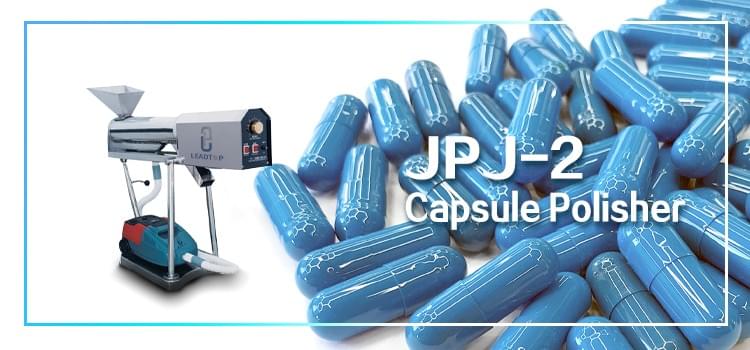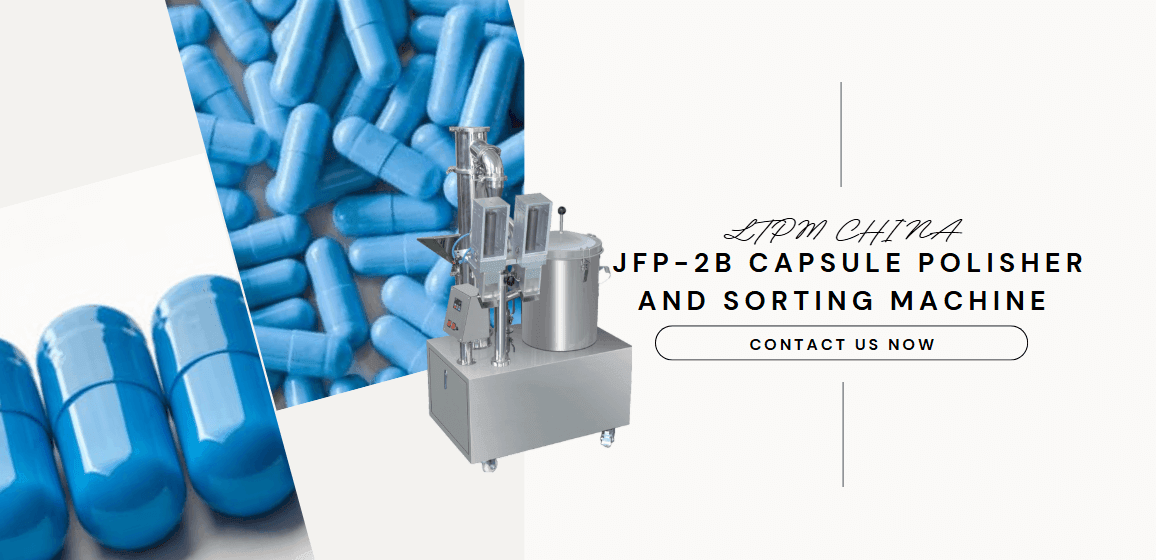During the capsule production process, even the most sophisticated equipment can still cause drug powder, fine debris, or static electricity to accumulate on the surface of finished capsules. Therefore, capsules must be polished after filling and before packaging. If polishing is omitted, drug powder can enter the blister packaging machine or bottling line . This can cause sensor blockage, damage to equipment parts , and frequent downtime. It can also lead to GMP inspection failure and higher scrap rates.
1. Capsule polishing method
- Manual polishing: The operator places a small amount of capsules with a soft cloth (such as flannel) or a fine-mesh sieve and manually shakes, tumbles, or wipes them . This method is only suitable for small-batch R&D , has low efficiency, and unstable quality .

- Horizontal polishing machine (inclined tube type): Still the most common type . This machine features a horizontal , slightly inclined polishing tube. Inside the tube is a high-speed rotating soft-bristled brush. Capsules enter from the upper end and, driven by the rotation of the brush and gravity, are scrubbed as they move forward. This machine has a simple structure and is widely used. However , powder easily accumulates in the lower tube , and the brush is easily contaminated by powder, which can wear away the ink printed on the capsules .

- Vertical polishing machines: A modern and recommended method, they minimize powder residue and are ideal for capsule printing . These machines feature a vertical design . Capsules enter a vertical polishing chamber through a top feed port, with a high-speed rotating main brush located in the center. As they fall, the capsules come into full contact with the rotating soft-bristle brush, scrubbing them thoroughly and thoroughly . Vacuum cleaning and side brushes remove powder from the main rotating brush , making them more suitable for capsule printing. However, the equipment costs are slightly higher than horizontal machines.
- Integrated polishing + dust removal + sorting unit: combines mechanical cleaning, vacuum extraction, metal detection and empty/low-weight capsule rejection in one unit. Best practices for modern capsule polishing .
2. How does a capsule polishing machine actually work?
Polishing machine entrance → rotary cleaning room → dust removal/ polishing/sorting → classification/metal detection → packaging.
The working process of the vertical polishing machine mainly includes the following steps:
- Feeding : The filled capsules are smoothly fed into the top hopper of the polishing machine through a synchronous conveying device.
- Rotating brushing : The capsule falls in the vertical polishing chamber and comes into full contact with the high-speed rotating soft brush to achieve comprehensive cleaning of the capsule surface.
- Dust removal and powder suction : In conjunction with the brushing process, the vacuum system generates a stable airflow to absorb the brushed powder and static electricity in real time to prevent secondary adhesion.
- Sorting and Inspection : Checkweighers, empty capsule rejectors, metal detectors and vision inspection systems remove defective products. Rejected products are sent to separate chutes or bins.
- Discharging : The cleaned capsules continue to be packaged.

Important design details: brush angle and speed, vacuum flow and filter capacity, ability to quickly disassemble for cleaning, compliant materials (stainless steel 316L), and integrated ports for metal detection/vision.
3. Why do you need a capsule polishing machine?
- Scalability and throughput: The polishing machine can process 7,000 capsules per minute , which is comparable to manual polishing .
- Quality consistency and compliance assurance : Machine cleaning parameters can be strictly controlled, recorded and verified to meet GMP, FDA and EMA regulatory requirements.
- Protect packaging equipment: Polished, dust-free capsules reduce sensor contamination and mechanical wear.
- Protecting the printed mark: Proper machine design protects the printing ink by controlling powder re-entry.
4. How to choose suitable polishing equipment ?
The following aspects should be given priority when selecting:
Choose a vertical capsule polishing machine , which is especially suitable for printed capsules and high-dust materials .
Investigate the vacuum cleaning efficiency and the design to prevent secondary residue .
Equipment should be easy to disassemble without tools , allowing for thorough cleaning and quick maintenance .
It is recommended to choose an integrated system that combines polishing, dust removal, and sorting to improve overall efficiency and consistency .
Ensure that the equipment has validation support documents (IQ/OQ/PQ protocols) and that the materials comply with GMP standards.
5. Maintenance, troubleshooting and operating tips
Daily/Batch:
- Empty and clean the dust cover and vacuum filter.
- Check and clean the brushes . Replace them on schedule.
- Check metal detectors and reject mechanisms.
Common problems and solutions:
- Ink/Marker Wear: Reduce brush pressure and speed . Use a vertical polisher . Ensure vacuum removes powder to keep brushes clean . Assess ink durability.
- Capsule blockage: Verify feed rate and hopper level . Adjust guide geometry . Check brush condition.
- Static electricity buildup: Add ionization rods or adjust compressed air . Verify extraction flow.
- High scrap rate: Verify filler settings (overfill/underfill), check detector calibration and check capsule supply quality.
- GMP Documentation: Maintain changeover logs, cleaning logs, filter change records, and validation test reports.
Related topics and answers
How to verify capsule polishing for GMP audit?
Verify IQ/OQ/PQ documentation, worst-case particulate challenge testing, cleaning validation, and acceptance criteria for visual cleanliness and scrap rates. Record routine maintenance and filter changes.
Do gelatin and HPMC capsules require different polishing settings?
Yes , because capsule shells vary in hardness and surface coating. Adjust the brush hardness, speed, and air/vacuum settings. Also, perform a small-scale test first.
How do I prevent ink markers from wearing off?
Use a vertical polisher equipped with effective dust extraction, verify ink curing and adhesion during development, minimize brush contact pressure, and use brushes made of low-abrasive materials.
Where should metal detectors be placed on the production line?
should be placed after the polisher and before packaging so that the capsules can be detected while they can still be removed individually.
How often should the brushes and filters be changed?
Follow the manufacturer's instructions and production usage . Check daily and replace brushes regularly based on the number of hours or batches. Replace the filter when vacuum performance degrades or according to the documented replacement interval.
Summary
Capsule polishing is no longer an optional process; it's a critical step in ensuring product quality, packaging efficiency, and regulatory compliance. Vertical polishing equipment and integrated systems effectively address industry challenges such as powder residue, print wear, and production matching, providing companies with sustainable operational advantages and market confidence.
If you are designing or upgrading a capsule production line and would like a turnkey solution that includes customization, a five-year warranty , and production-proven polishing/dust removal/sorting modules, please contact LTPM CHINA, a specialist in capsule filling and subsequent polishing and packaging lines. Our solutions are designed for high throughput, easy cleaning, and proven operation.